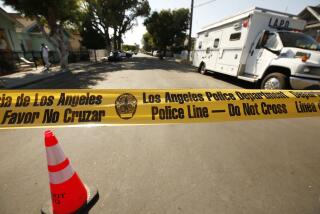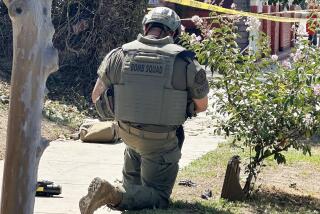Whose Piggy Bank? : ‘Bomb’ Is Just a Two-Bit Device
- Share via
For a while there Wednesday morning it looked pretty ominous on West 2nd Street. What looked like a very large pipe bomb was leaning against the retaining wall of a Los Angeles Department of Public Works maintenance building.
At about 8 a.m. a resident spotted it and called the Police Department, which dispatched its four-man bomb squad, plus a large contingent of other officers, to the scene.
The city Fire Department dispatched an ambulance, an engine company and a battalion chief.
The bomb squad gingerly inspected the device. It was four inches in diameter and eight inches long--as pipe bombs go, a virtual blockbuster.
“I’ve never heard of one that big,” said police spokesman Lt. Dan Cooke.
The bomb squad was exceptionally careful. It ordered traffic diverted around the neighborhood in the 1200 block of West 2nd. Firemen told residents in the four square blocks around the site to evacuate the area.
Detective Dave Weller of the bomb squad said he and his colleagues carefully placed sandbags around the pipe and then attached a small explosive charge to the device, covered it with a special “bomb blanket” and retreated 200 feet.
Then, at 10 a.m., crouching behind a brick wall, they set off the small charge by remote control, which in turn was supposed to set off whatever heavier charge of explosive was in the pipe.
But there was no Big Boom--just the moderate bang of the small charge, and no damage at all. Examining the “bomb” afterward, the experts discovered that the pipe had a small slot cut in the top. And inside was 51 cents--two quarters and a penny.
“The bomb,” said Lt. Cooke, “was somebody’s piggy bank.”
Weller was not at all amused; any possible bomb is handled with the greatest caution. “It caused a lot of trouble and fear in the neighborhood,” he said.
He said the meager piggy-bank savings have been recorded at Parker Center as found property. The owner may recover it if he can somehow provide positive identification of the coins, Weller added.
More to Read
Sign up for Essential California
The most important California stories and recommendations in your inbox every morning.
You may occasionally receive promotional content from the Los Angeles Times.













